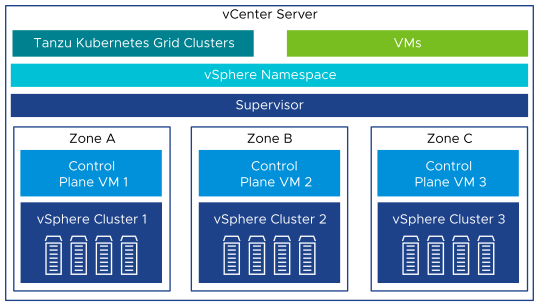Learn what are the differences between deploying a Supervisor on three vSphere clusters mapped to vSphere zones, and a single-cluster deployment of the Supervisor that maps to one vSphere Zone.
Three-Zone Deployment of the Supervisor for Cluster-Level HA
You can enable vSphere IaaS control plane on three vSphere clusters that are mapped to three vSphere Zones. You configure each vSphere cluster as an independent failure domain and map it to one vSphere zone. In a three-zone deployment, all three vSphere clusters become one Supervisor. In a three-zone deployment, you can:
- Provide cluster-level high-availability to the Supervisor as each vSphere cluster is an independent failure domain.
- Distribute the nodes of your TKG clusters across all three vSphere zones, thus providing HA for your Kubernetes workloads at a vSphere cluster level.
- Scale the Supervisor by adding hosts to each of the three vSphere clusters.

Placement of vSphere Zones Across Physical Sites
You can distribute vSphere zones across different physical sites as long as the latency between the sites doesn't exceed 100 ms. For example, you can distribute the vSphere zones across two physical sites - one vSphere zone on the first site, and two vSphere zones on the second site.
Single-Cluster Deployment of the Supervisor
